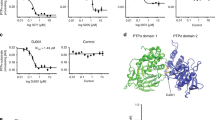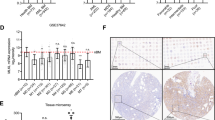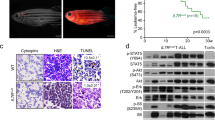Abstract
Neurotrophins and their receptors play a key role in neurogenesis and survival. However, we and others have recently obtained evidence for a potential involvement of this receptor system in leukemia. To investigate mechanisms underlying the leukemogenic potential of activated neurotrophin receptor signaling, we analyzed in vivo leukemogenesis mediated by ΔTrkA, a mutant of TRKA (tropomyosin-related kinase A) isolated from a patient with acute myeloid leukemia (AML). Retroviral expression of ΔTrkA in myeloid 32D cells induced AML in syngeneic C3H/Hej mice (n=11/11, latency ∼4 weeks). C57Bl/6J mice transplanted with ΔTrkA-transduced primary lineage negative (Lin−) bone marrow cells died of a transient polyclonal AML (n=7/15, latency of <12 days). Serial transplantation of AML cells did not re-induce this disease but rather acute lymphoblastic leukemia (ALL, latency >78 days). All primary recipients surviving the early AML developed clonal ALL or myeloid leukemia (latency >72 days) that required additional genetic lesions. PI3K and mTOR-raptor were identified as the crucial mediators of leukemic transformation, whereas STAT and MAP kinase signaling pathways were not activated. Thus, our findings reveal potent and unique transforming properties of altered neurotrophin receptor signaling in leukemogenesis, and encourage further analyses of neurotrophin receptors and downstream signaling events in hematological malignancies.
This is a preview of subscription content, access via your institution
Access options
Subscribe to this journal
Receive 12 print issues and online access
$259.00 per year
only $21.58 per issue
Buy this article
- Purchase on Springer Link
- Instant access to full article PDF
Prices may be subject to local taxes which are calculated during checkout




Similar content being viewed by others
References
Deguchi K, Gilliland DG . Cooperativity between mutations in tyrosine kinases and in hematopoietic transcription factors in AML. Leukemia 2002; 16: 740–744.
Frohling S, Scholl C, Gilliland DG, Levine RL . Genetics of myeloid malignancies: pathogenetic and clinical implications. J Clin Oncol 2005; 23: 6285–6295.
Scheijen B, Griffin JD . Tyrosine kinase oncogenes in normal hematopoiesis and hematological disease. Oncogene 2002; 21: 3314–3333.
Blume-Jensen P, Hunter T . Oncogenic kinase signalling. Nature 2001; 411: 355–365.
Shaw RJ, Cantley LC . Ras, PI(3)K and mTOR signalling controls tumour cell growth. Nature 2006; 441: 424–430.
Lee FS, Kim AH, Khursigara G, Chao MV . The uniqueness of being a neurotrophin receptor. Curr Opin Neurobiol 2001; 11: 281–286.
Pyle AD, Lock LF, Donovan PJ . Neurotrophins mediate human embryonic stem cell survival. Nat Biotechnol 2006; 24: 344–350.
Descamps S, Pawlowski V, Revillion F, Hornez L, Hebbar M, Boilly B et al. Expression of nerve growth factor receptors and their prognostic value in human breast cancer. Cancer Res 2001; 61: 4337–4340.
Douma S, Van Laar T, Zevenhoven J, Meuwissen R, Van Garderen E, Peeper DS . Suppression of anoikis and induction of metastasis by the neurotrophic receptor TrkB. Nature 2004; 430: 1034–1039.
McGregor LM, McCune BK, Graff JR, McDowell PR, Romans KE, Yancopoulos GD et al. Roles of trk family neurotrophin receptors in medullary thyroid carcinoma development and progression. Proc Natl Acad Sci USA 1999; 96: 4540–4545.
Labouyrie E, Dubus P, Groppi A, Mahon FX, Ferrer J, Parrens M et al. Expression of neurotrophins and their receptors in human bone marrow. Am J Pathol 1999; 154: 405–415.
Kaebisch A, Brokt S, Seay U, Lohmeyer J, Jaeger U, Pralle H . Expression of the nerve growth factor receptor c-TRK in human myeloid leukaemia cells. Br J Haematol 1996; 95: 102–109.
Eguchi M, Eguchi-Ishimae M, Tojo A, Morishita K, Suzuki K, Sato Y et al. Fusion of ETV6 to neurotrophin-3 receptor TRKC in acute myeloid leukemia with t(12;15)(p13;q25). Blood 1999; 93: 1355–1363.
Liu Q, Schwaller J, Kutok J, Cain D, Aster JC, Williams IR et al. Signal transduction and transforming properties of the TEL-TRKC fusions associated with t(12;15)(p13;q25) in congenital fibrosarcoma and acute myelogenous leukemia. EMBO J 2000; 19: 1827–1838.
Reuther GW, Lambert QT, Caligiuri MA, Der CJ . Identification and characterization of an activating TrkA deletion mutation in acute myeloid leukemia. Mol Cell Biol 2000; 20: 8655–8666.
Arevalo JC, Conde B, Hempstead BL, Chao MV, Martin-Zanca D, Perez P . TrkA immunoglobulin-like ligand binding domains inhibit spontaneous activation of the receptor. Mol Cell Biol 2000; 20: 5908–5916.
Mulloy JC, Jankovic V, Wunderlich M, Delwel R, Cammenga J, Krejci O et al. AML1-ETO fusion protein up-regulates TRKA mRNA expression in human CD34+ cells, allowing nerve growth factor-induced expansion. Proc Natl Acad Sci USA 2005; 102: 4016–4021.
Li Z, Dullmann J, Schiedlmeier B, Schmidt M, von Kalle C, Meyer J et al. Murine leukemia induced by retroviral gene marking. Science 2002; 296: 497.
Beutel G, Meyer J, Ma L, Yin S, Eder M, von Neuhoff N et al. Expression of the p75 neurotrophin receptor in acute leukaemia. Br J Haematol 2005; 131: 67–70.
Follo MY, Mongiorgi S, Bosi C, Cappellini A, Finelli C, Chiarini F et al. The Akt/mammalian target of rapamycin signal transduction pathway is activated in high-risk myelodysplastic syndromes and influences cell survival and proliferation. Cancer Res 2007; 67: 4287–4294.
Recher C, Beyne-Rauzy O, Demur C, Chicanne G, Dos Santos C, Mas VM et al. Antileukemic activity of rapamycin in acute myeloid leukemia. Blood 2005; 105: 2527–2534.
Martelli AM, Nyakern M, Tabellini G, Bortul R, Tazzari PL, Evangelisti C et al. Phosphoinositide 3-kinase/Akt signaling pathway and its therapeutical implications for human acute myeloid leukemia. Leukemia 2006; 20: 911–928.
Li Z, Schwieger M, Lange C, Kraunus J, Sun H, van den Akker E et al. Predictable and efficient retroviral gene transfer into murine bone marrow repopulating cells using a defined vector dose. Exp Hematol 2003; 31: 1206–1214.
Li Z, Kustikova OS, Kamino K, Neumann T, Rhein M, Grassman E et al. Insertional mutagenesis by replication-deficient retroviral vectors encoding the large T oncogene. Ann N Y Acad Sci 2007; 1106: 95–113.
Huntly BJ, Shigematsu H, Deguchi K, Lee BH, Mizuno S, Duclos N et al. MOZ-TIF2, but not BCR-ABL, confers properties of leukemic stem cells to committed murine hematopoietic progenitors. Cancer Cell 2004; 6: 587–596.
Kogan SC, Ward JM, Anver MR, Berman JJ, Brayton C, Cardiff RD et al. Bethesda proposals for classification of nonlymphoid hematopoietic neoplasms in mice. Blood 2002; 100: 238–245.
Kustikova O, Fehse B, Modlich U, Yang M, Dullmann J, Kamino K et al. Clonal dominance of hematopoietic stem cells triggered by retroviral gene marking. Science 2005; 308: 1171–1174.
Meyer J, Jucker M, Ostertag W, Stocking C . Carboxyl-truncated STAT5beta is generated by a nucleus-associated serine protease in early hematopoietic progenitors. Blood 1998; 91: 1901–1908.
Frank O, Rudolph C, Heberlein C, von Neuhoff N, Schrock E, Schambach A et al. Tumor cells escape suicide gene therapy by genetic and epigenetic instability. Blood 2004; 104: 3543–3549.
Li S, Ilaria Jr RL, Million RP, Daley GQ, Van Etten RA . The P190, P210, and P230 forms of the BCR/ABL oncogene induce a similar chronic myeloid leukemia-like syndrome in mice but have different lymphoid leukemogenic activity. J Exp Med 1999; 189: 1399–1412.
Wakabayashi Y, Watanabe H, Inoue J, Takeda N, Sakata J, Mishima Y et al. Bcl11b is required for differentiation and survival of alphabeta T lymphocytes. Nat Immunol 2003; 4: 533–539.
Satterwhite E, Sonoki T, Willis TG, Harder L, Nowak R, Arriola EL et al. The BCL11 gene family: involvement of BCL11A in lymphoid malignancies. Blood 2001; 98: 3413–3420.
Mizuki M, Fenski R, Halfter H, Matsumura I, Schmidt R, Muller C et al. Flt3 mutations from patients with acute myeloid leukemia induce transformation of 32D cells mediated by the Ras and STAT5 pathways. Blood 2000; 96: 3907–3914.
Kaplan DR, Miller FD . Neurotrophin signal transduction in the nervous system. Curr Opin Neurobiol 2000; 10: 381–391.
Hornberger TA, Chu WK, Mak YW, Hsiung JW, Huang SA, Chien S . The role of phospholipase D and phosphatidic acid in the mechanical activation of mTOR signaling in skeletal muscle. Proc Natl Acad Sci USA 2006; 103: 4741–4746.
Fang Y, Vilella-Bach M, Bachmann R, Flanigan A, Chen J . Phosphatidic acid-mediated mitogenic activation of mTOR signaling. Science 2001; 294: 1942–1945.
Min DS, Ahn BH, Rhie DJ, Yoon SH, Hahn SJ, Kim MS et al. Expression and regulation of phospholipase D during neuronal differentiation of PC12 cells. Neuropharmacology 2001; 41: 384–391.
Watanabe H, Yokozeki T, Yamazaki M, Miyazaki H, Sasaki T, Maehama T et al. Essential role for phospholipase D2 activation downstream of ERK MAP kinase in nerve growth factor-stimulated neurite outgrowth from PC12 cells. J Biol Chem 2004; 279: 37870–37877.
Voss M, Weernink PA, Haupenthal S, Moller U, Cool RH, Bauer B et al. Phospholipase D stimulation by receptor tyrosine kinases mediated by protein kinase C and a Ras/Ral signaling cascade. J Biol Chem 1999; 274: 34691–34698.
Davies SP, Reddy H, Caivano M, Cohen P . Specificity and mechanism of action of some commonly used protein kinase inhibitors. Biochem J 2000; 351: 95–105.
Sarbassov DD, Guertin DA, Ali SM, Sabatini DM . Phosphorylation and regulation of Akt/PKB by the rictor-mTOR complex. Science 2005; 307: 1098–1101.
Zipursky A, Brown E, Christensen H, Sutherland R, Doyle J . Leukemia and/or myeloproliferative syndrome in neonates with Down syndrome. Semin Perinatol 1997; 21: 97–101.
Tacconelli A, Farina AR, Cappabianca L, Desantis G, Tessitore A, Vetuschi A et al. TrkA alternative splicing: a regulated tumor-promoting switch in human neuroblastoma. Cancer Cell 2004; 6: 347–360.
Lee FS, Chao MV . Activation of Trk neurotrophin receptors in the absence of neurotrophins. Proc Natl Acad Sci USA 2001; 98: 3555–3560.
Watson FL, Porcionatto MA, Bhattacharyya A, Stiles CD, Segal RA . TrkA glycosylation regulates receptor localization and activity. J Neurobiol 1999; 39: 323–336.
Banno Y, Ohguchi K, Matsumoto N, Koda M, Ueda M, Hara A et al. Implication of phospholipase D2 in oxidant-induced phosphoinositide 3-kinase signaling via Pyk2 activation in PC12 cells. J Biol Chem 2005; 280: 16319–16324.
Joseph T, Wooden R, Bryant A, Zhong M, Lu Z, Foster DA . Transformation of cells overexpressing a tyrosine kinase by phospholipase D1 and D2. Biochem Biophys Res Commun 2001; 289: 1019–1024.
Acknowledgements
This study was supported by the Deutsche Krebshilfe (grant: 10-2090-Li I) and DFG excellence cluster REBIRTH. CB is also supported by the National Cancer Institute (R01-CA107492-01A2). MR is a student of the MD/PhD program in Hannover Medical School, supported by the Deutsche José Carreras Leukämie-Stiftung (grant: DJCLS F05/10). BF's group was supported by the DFG (FE568/5-2). GWR was supported by the National Cancer Institute (K01CA098330) and the V Foundation for Cancer Research. We are very grateful to Maimona Id, Nicole Brauer-Dewor and Dung Ludwig for technical assistance, Daniel Wicke and Viktor Grünwald for providing 32D MPL cells and antibodies against S6 protein, and Rolf Baumann, Hans Grundtke, Jörg Frühauf and Bernd Polivka (Radiotherapy, Hannover Medical School) for irradiation of animals.
Author information
Authors and Affiliations
Corresponding author
Additional information
Supplementary Information accompanies the paper on the Leukemia website (http://www.nature.com/leu)
Supplementary information
Rights and permissions
About this article
Cite this article
Meyer, J., Rhein, M., Schiedlmeier, B. et al. Remarkable leukemogenic potency and quality of a constitutively active neurotrophin receptor, ΔTrkA. Leukemia 21, 2171–2180 (2007). https://doi.org/10.1038/sj.leu.2404882
Received:
Revised:
Accepted:
Published:
Issue Date:
DOI: https://doi.org/10.1038/sj.leu.2404882
Keywords
This article is cited by
-
Revisiting NTRKs as an emerging oncogene in hematological malignancies
Leukemia (2019)
-
The new and recurrent FLT3 juxtamembrane deletion mutation shows a dominant negative effect on the wild-type FLT3 receptor
Scientific Reports (2016)
-
Leukemogenic potency of the novel FLT3-N676K mutant
Annals of Hematology (2016)
-
Hyperactivation of mTORC1 and mTORC2 by multiple oncogenic events causes addiction to eIF4E-dependent mRNA translation in T-cell leukemia
Oncogene (2015)
-
Mature T-cell Lymphomagenesis Induced by Retroviral Insertional Activation of Janus Kinase 1
Molecular Therapy (2013)



